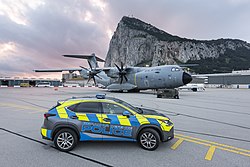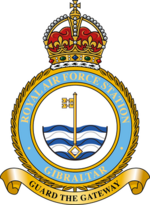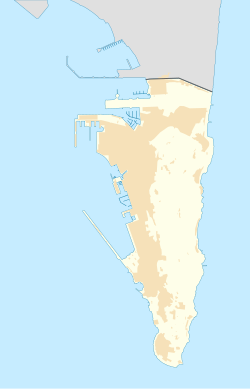RAF Gibraltar
Royal Air Force station in Gibraltar From Wikipedia, the free encyclopedia
Royal Air Force Gibraltar or more simply RAF Gibraltar (also formerly known as North Front) is a Royal Air Force station on Gibraltar. No military aircraft are currently stationed there, but RAF and aircraft of other NATO nations will periodically arrive for transient stopovers, exercises, or other temporary duty. Administered by British Forces Gibraltar, the station is a joint civil-military facility that also functions as the Rock's civilian airport – Gibraltar Airport, with the civilian airport's passenger terminal building and apron facilities located on the north side of the runway while the apron and hangar of RAF Gibraltar are located on the south side of the runway.
| RAF Gibraltar | |||||||
|---|---|---|---|---|---|---|---|
| Gibraltar | |||||||
 | |||||||
 Guard the Gateway | |||||||
| Coordinates | 36°08′58″N 005°20′50″W | ||||||
| Type | Permanent Joint Operating Base | ||||||
| Site information | |||||||
| Owner | Ministry of Defence | ||||||
| Operator | Royal Air Force | ||||||
| Controlled by | British Forces Gibraltar | ||||||
| Condition | Operational | ||||||
| Website | Official website | ||||||
| Site history | |||||||
| Built | 1942 | ||||||
| In use | 1942–present | ||||||
| Garrison information | |||||||
| Current commander | Wing Commander Tom Harvey | ||||||
| Airfield information | |||||||
| Identifiers | IATA: GIB, ICAO: LXGB, WMO: 8495 | ||||||
| Elevation | 3.7 metres (12 ft) AMSL | ||||||
| |||||||
| Airfield shared with a civilian terminal Source: RAF Gibraltar Defence Aerodrome Manual[1] | |||||||
A total of 16 personnel were reported assigned to RAF Gibraltar as of 2023.[2]
History
Early history
A Royal Naval Air Service seaplane base was opened at Gibraltar during the First World War.[3]
The airport was constructed during World War II when Gibraltar was an important naval base for the British. Originally opened in 1939, it was only an emergency airfield for the Royal Navy's Fleet Air Arm. However, the runway was later extended by reclaiming some land from the Bay of Gibraltar using rock blasted from the Rock of Gibraltar while carrying out works on military tunnels. This last major extension of the runway allowed larger aircraft to land at Gibraltar. At this time the airfield completely obliterated the former Gibraltar horse racing track.[4]
On 25 September 1939, No. 200 (Coastal) Group RAF was formed as a subordinate formation to HQ RAF Mediterranean in control of No. 202 Squadron RAF.[5] The Group's function was the control of Royal Air Force units operating from Gibraltar.[5] In late 1940 the Group was transferred to Coastal Command.[5] Later a joint RN/RAF Area Combined Headquarters was formed which commenced operations in early 1942.[6]
RAF North Front opened in 1942 and RAF New Camp opened around the same time. RAF New Camp was built on reclaimed land in the harbour next to Montagu Bastion[7] and was the site for a slipway and hangar for flying boats and RAF motor launches.[8][9]
The airfield played a major part in Operation Torch, the Anglo-American invasion of French North Africa (French colonial possessions in Algeria, Tunisia and Morocco) in November 1942.[7]
Following the major reorganization of the Allied air forces at the Casablanca Conference in January 1943, RAF Gibraltar became a major sub-command of the Mediterranean Air Command under Air Chief Marshal Sir Arthur Tedder in February 1943.[10]
Anti-submarine warfare was a major priority of RAF Gibraltar during the later years of the Second World War and some of their aircraft were equipped with special detectors to locate German U-boats in the relatively shallow waters around Gibraltar. United States Navy Fleet Air Wing 15 based at Port Lyautey[11] coordinated its antisubmarine warfare operations with RAF Gibraltar and assigned a ZP-14 Squadron blimp pilot/liaison officer to Gibraltar.[12][13]
Post-war
On 29 May 1945 the Area Combined Headquarters was shut down and most of the personnel sent home.[14] Weather flights from Gibraltar were maintained at the end of the war by No. 520 Squadron RAF flying Halifaxes. This was superseded by a detachment of No. 518 Squadron RAF from Aldergrove, and then by the arrival of No. 224 Squadron RAF. Initially the squadron dispatched a detachment in May 1948, but the whole squadron moved to Gibraltar in August 1951.[15] It was re-equipped with Avro Shackletons. The station officially became "RAF Gibraltar" in 1966.[16]
The RAF camp, now known as Devil's Tower Camp, which was increasingly used by the British Army in the 1960s and 1970s, became the home of the Royal Gibraltar Regiment.[17]
By the 1980s RAF Gibraltar was increasingly being used as a Forward Operating Base for middle east operations.[7]

On 4 February 2011, the new RAF headquarters in Gibraltar was officially opened by The Chief of Joint Operations, Air Marshal Sir Stuart Peach.[18]
In 2016 a major runway resurfacing project was completed ensuring both military and civilian flights could continue.[19]
Units stationed
| RAF Units | Aircraft |
|---|---|
| No. 48 Squadron | Lockheed Hudson |
| No. 179 Squadron | Vickers Wellington |
| No. 202 Squadron | Consolidated Catalina |
| No. 210 Squadron | Catalina |
| No. 233 Squadron | Hudson |
| No. 248 Squadron Detachment | Bristol Beaufighter |
| No. 544 Squadron Detachment | Supermarine Spitfire |
| No. 813 Squadron, Fleet Air Arm | Fairey Swordfish |
| No. 1403 (Meteorological) Flight | Handley Page Hampden, Gloster Gladiator |
Commanding officers
- Air Vice-Marshal Sturley Simpson – AOC, AHQ Gibraltar, December 1941 to Feb 1944
- Air Vice Marshal William Elliot – AOC, RAF Gibraltar, Feb 1944 to June 1944
- Air Vice Marshal Alick Stevens – AOC, RAF Gibraltar, June 1944 to August 1945
Gibraltar squadrons
- No. 224 Squadron RAF (Disbanded)
Gallery
- The modern day control tower of RAF Gibraltar/Gibraltar Airport
- The runway of RAF Gibraltar/Gibraltar Airport looking from East to West
- A Lockheed Hudson of No. 233 Squadron RAF leaves its dispersal at Gibraltar for a reconnaissance sortie, in August 1942.
- Goodyear ZNP-K ships of United States Navy Blimp Squadron ZP-14 coordinated their anti-submarine warfare operations with RAF Gibraltar in 1944.
Panoramic view
See also
References
Further reading
External links
Wikiwand in your browser!
Seamless Wikipedia browsing. On steroids.
Every time you click a link to Wikipedia, Wiktionary or Wikiquote in your browser's search results, it will show the modern Wikiwand interface.
Wikiwand extension is a five stars, simple, with minimum permission required to keep your browsing private, safe and transparent.






